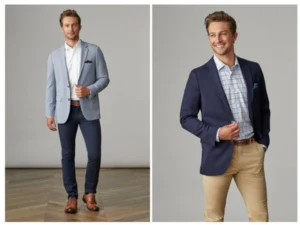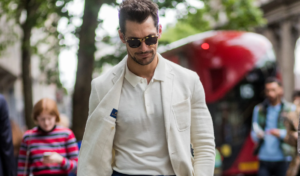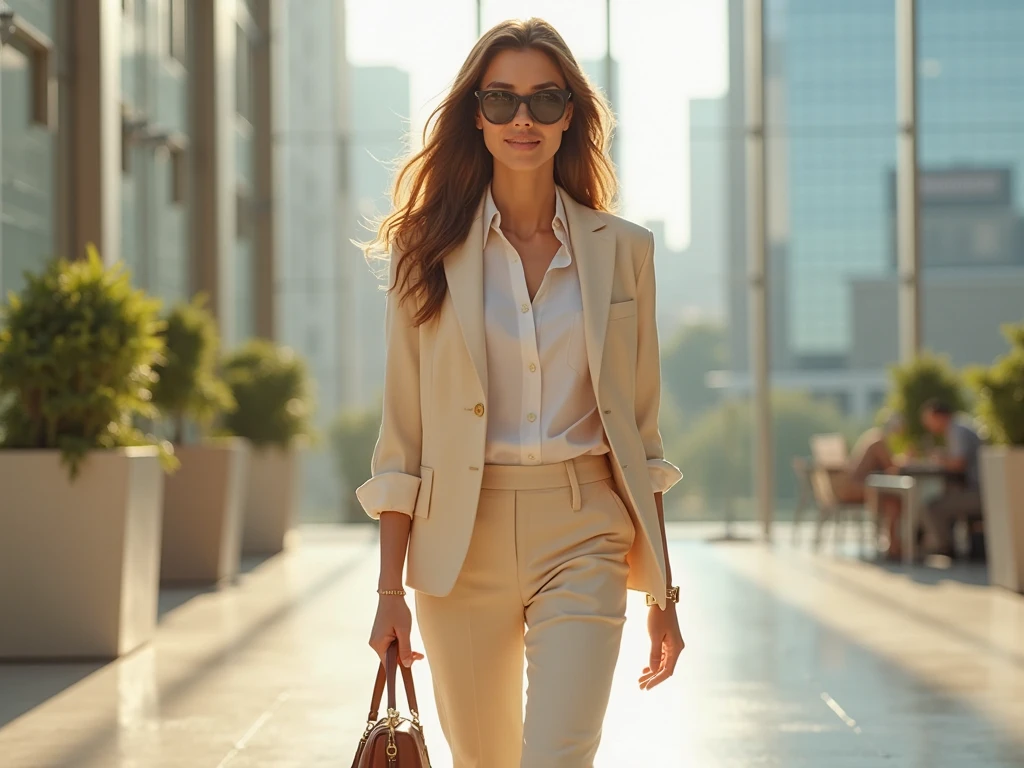
What Is Business Casual for Men: Essential Tips to Impress or Fail
What is business casual for men? It’s a dress code that sits between formal suits and relaxed weekend wear—perfect for offices, meetings, and events where you need to look sharp but not stiff. Nail it, and you’ll project confidence. Get it wrong, and you might stand out for the wrong reasons.
Why Does Business Casual Matter?
What is business casual for men, and why should you care? In today’s professional world, your appearance speaks before you do. Business casual strikes the perfect balance between formal professionalism and relaxed comfort, making it ideal for modern workplaces, client meetings, and networking events.
Key Benefits of Business Casual for Men:
- Builds Professional Credibility – A well-put-together look earns trust and respect
- Adapts to Workplace Culture – Fits both corporate offices and creative environments
- Boosts Confidence – When you look polished, you naturally feel more self-assured
- Maintains Comfort – No stiff suits, but still maintains a sharp appearance
Getting business casual right shows you understand professional expectations while keeping your personal style. Whether you’re in an interview, daily office setting, or important meeting, dressing appropriately can make all the difference.
You May Also Like: What is business casual woman
The Essential Men’s Business Casual Wardrobe
1. Shirts (The Foundation of Business Casual)
- Crisp button-down shirts in solid colors (white, light blue, pale pink)
- Subtle patterned dress shirts (thin stripes, small checks)
- Well-fitted polo shirts in neutral tones (navy, gray, black)
2. Pants (Structured Yet Comfortable)
- Classic chinos in khaki, navy, or gray
- Tailored dress pants in wool or cotton blends
- Dark, well-fitted jeans (only if your workplace allows)
3. Footwear (Polished and Professional)
- Leather loafers or derbies for a classic look
- Clean, minimalist leather sneakers in neutral colors
- Oxford shoes for more formal business casual occasions
4. Layering Pieces (For Versatility)
- Unstructured blazers in navy or gray
- V-neck or crewneck sweaters in solid colors
- Lightweight cardigans for transitional weather
5. Accessories (Subtle Finishing Touches)
- Leather belt that matches your shoes
- Simple wristwatch with a clean face
- Minimalist tie (optional for more formal settings)
Also Read: Smart casual vs business casual
Common Business Casual Mistakes (And How to Avoid Them)
Navigating the world of business casual attire can be tricky. While it offers more flexibility than formal wear, it still requires a level of professionalism. If you want to make the right impression at work, avoiding these common business casual mistakes is key.
1. Confusing Business Casual with Casual
One of the biggest common business casual mistakes is dressing too casually. Just because “casual” is in the name doesn’t mean jeans with holes or graphic t-shirts are appropriate. Business casual should strike a balance—think slacks, blouses, button-down shirts, and modest dresses.
How to Avoid It: Always err on the side of being slightly more formal, especially if you’re new to the workplace. Observe what your colleagues wear and adjust accordingly.
2. Wearing Wrinkled or Poorly Fitted Clothes
Even if your outfit checks all the boxes, if it’s wrinkled or doesn’t fit well, it can come off as unprofessional. Oversized pants, tight blouses, or baggy shirts are common pitfalls.
How to Avoid It: Invest in well-fitted staples and learn how to iron or steam your clothes properly. Tailoring can go a long way in improving the look of your wardrobe.
3. Ignoring Footwear
Shoes are often overlooked but they’re a crucial part of any outfit. Worn-out sneakers or flip-flops can ruin a business casual look.
How to Avoid It: Opt for clean, polished shoes like loafers, ballet flats, or ankle boots. Save the flip-flops for the beach.
4. Overdoing Accessories or Makeup
Too many accessories or heavy makeup can distract from your professionalism. Business casual is about clean, polished presentation—not standing out for the wrong reasons.
How to Avoid It: Keep accessories simple and makeup natural. A pair of earrings or a wristwatch is enough to enhance your look without overdoing it.
5. Not Dressing for the Industry or Company Culture
What’s appropriate for one workplace might not work in another. For instance, a tech startup may embrace a more relaxed style compared to a law firm.
How to Avoid It: Pay attention to your environment. When in doubt, ask HR or check your company’s dress code policy.
6. Neglecting Grooming
Neat grooming is a crucial part of any dress code. Messy hair or chipped nail polish can take away from an otherwise professional appearance.
How to Avoid It: Maintain a clean and tidy look. Regular haircuts and attention to personal hygiene can make a significant difference.
7. Forgetting Seasonal Adjustments
Wearing summer clothes in winter or layering too much during warm months can make you uncomfortable and look unprepared.
How to Avoid It: Choose season-appropriate fabrics and layers. Wool, cotton, and breathable blends can help you stay stylish and comfortable all year round.
Business Casual Outfits for Different Situations
1. Office (Traditional Setting)

- Shirt: Light blue button-down
- Pants: Gray dress pants
- Shoes: Brown loafers
- Extra: A slim-fit blazer if needed
2. Creative Workplace (More Relaxed)

- Shirt: Dark polo shirt
- Pants: Black tailored jeans
- Shoes: Clean white leather sneakers
3. Job Interviews (Better Safe Than Sorry)

- Shirt: White or light-colored dress shirt
- Pants: Navy chinos
- Shoes: Dark brown Oxfords
- Extra: A simple watch for a polished touch
4. Client Meetings/External Events

- Light gray or beige dress pants
- Button-down shirt with subtle pattern
- Navy sport coat or blazer
- Leather belt matching shoe color
5. Casual Friday/Relaxed Office

- Well-fitted polo shirt in neutral tone
- Khaki or olive chinos
- Clean minimalist sneakers or boat shoes
- Optional: Light sweater or cardigan
6. Business Casual in Warmer Weather

- Linen or cotton blend dress shirt
- Light-colored chinos or dress pants
- Loafers without socks (for smart casual look)
- Sunglasses with professional frames
7. Business Casual in Colder Weather

- Wool blend dress pants
- Long-sleeve button-down with sweater overlay
- Leather boots or brogues
- Wool overcoat for outerwear
FAQs About Men’s Business Casual
Q: What is business casual for men in simple terms?
A: Business casual for men means professional yet relaxed attire – typically dress shirts or polos with chinos or dress pants, avoiding both full suits and casual jeans/t-shirts.
Q: Can I wear jeans in a business casual workplace?
A: Some offices allow dark, well-fitted jeans without distressing. Always check your company policy first, and pair them with dressier tops and shoes.
Q: Are sneakers acceptable for business casual?
A: Clean, leather sneakers in neutral colors can work in creative environments, but traditional offices typically require dress shoes or loafers.
Q: Do I need to wear a blazer for business casual?
A: Blazers aren’t always required but add polish for important meetings. An unstructured navy or gray blazer is most versatile.
Q: What colors work best for business casual outfits?
A: Stick to neutral tones like navy, gray, white, and beige. You can add subtle patterns or colors in moderation.
Q: How formal should business casual shirts be?
A: Opt for button-down collars in solid colors or subtle patterns. Polo shirts work in more relaxed environments.
Q: Can I wear shorts in business casual settings?
A: Generally no – even in hot weather, opt for lightweight dress pants or well-fitted chinos instead.
Q: What’s the biggest mistake men make with business casual?
A: Dressing too casually by wearing wrinkled clothes, athletic shoes, or ill-fitting garments that look sloppy.
Q: How can I make my business casual look more professional?
A: Focus on perfect fit, quality fabrics, and polished shoes. Adding a blazer or dress watch elevates the look.
Q: Does business casual vary by industry?
A: Absolutely – finance and law lean more formal, while tech and creative fields accept more relaxed interpretations.
Final Thoughts: What Is Business Casual for Men?
Understanding what is business casual for men ultimately comes down to finding the perfect balance between professionalism and comfort. It’s about dressing appropriately for your workplace while maintaining your personal style. The key elements – well-fitted shirts, tailored pants, polished shoes, and smart layering – create a versatile foundation that works for most professional settings. Remember that fit, fabric quality, and attention to detail matter more than following strict fashion rules.
As workplaces continue evolving, what is business casual for men may vary across industries and companies. The most reliable approach is to observe your workplace culture, invest in versatile staples, and dress slightly better than the minimum requirement. When executed properly, business casual projects confidence, competence, and professionalism without sacrificing comfort. Whether you’re heading to the office, a client meeting, or a networking event, mastering this dress code ensures you always make the right impression.


